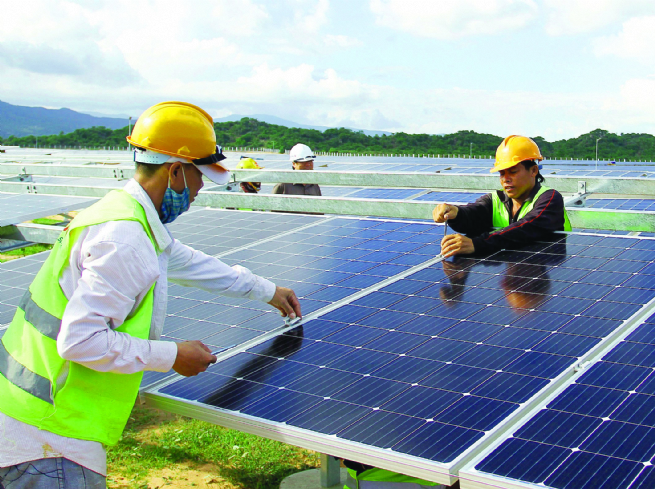9:02:09 AM | 1/15/2020
Having received a lot of recommendations from experts, on December 3, 2019, Deputy Prime Minister Trinh Dinh Dung signed Decision 1743 approving the task of making a master plan on national energy in the 2021-2030 period, with a vision to 2050. This document addresses fragmentation in the planning of energy sub-sectors.
During the development process until 2019, Vietnam has developed energy sub-sectoral plans, including: seven national electricity development plans; five coal industry development plans; three oil and gas development plans; Draft Renewable Energy Plan; Draft National Energy Development Plan (2016-2025 period), with orientation to 2035 (formulated in June 2017). In addition, there is a national energy development strategy until 2050 (drafted in 2007). Many experts have pointed out the inadequacies in the system of such planning, such as: Inconsistent planning method; low uniformity, unreasonable investment structure in each sub-sector and among sub-sectors, leading to inconsistency. Consequently, a newly approved plan is outdated and needs to be adjusted (Electricity Master Plan VII).

Comprehensive settlement
If the objectives of the newly approved planning task are met, the Vietnamese energy sector will fully address the shortcomings of the above situation. In the task of planning the objective of reviewing, analyzing and assessing the current state of development of energy sub-sectors (coal, oil, gas, renewable energy) in the period of 2011-2020 and actualizing the content of recent energy sector plans have been put in place first. At the same time, the mission also sets out the goal of forecasting energy demand according to fuel types and economic sectors in the period of 2021 - 2030 and the period of 2031 - 2050 based on the current situation and socio-economic development trends forecast and energy demand assessment for the period of 2011 - 2020.
Other specific objectives identified in the mission include: Research approaches for developing energy sub-sectors and energy efficiency; select a number of options with good economic and technical indicators and high feasibility, ensure adequate energy supply for socio-economic development, economical use of energy resources, consider the strong development of renewable energy sources, with regard to the import and export of energy; propose solutions to develop energy system infrastructure nationwide and territories in the 2021 - 2030 period with a vision to 2050. Other objectives include: analyze energy infrastructure system development plan, assess sectoral and regional linkages, identify socio-economic development requirements as well as development opportunities and challenges for the energy sector, assess the alignment and synchronization between the overall infrastructure of the domestic energy industry with the region and the world, list of important national projects, investment priority projects of energy sub-sectors and order of priority for implementation. They also include: assess environmental impacts and prepare strategic environmental assessment for the overall planning of energy with the orientation of land use arrangement and environmental protection, response to climate change and conserve national-ranked ecology, landscapes and monuments, study and propose major solutions on development policy mechanisms, organize the implementation of planning, and ensure the sustainable development of national energy.
Feasible solutions for Vietnam's energy problem
According to experts, it is a long way from the approved mission to a truly feasible scientific national energy master plan. In the context of climate change negatively impacting the world, Vietnam also faces the problem of finding new energy sources to provide enough energy. To improve economic and living standards, and to improve the air pollution caused by fossil-powered power plants.
In November 2019, the Vietnam Energy Outlook 2019 Report (EOR19) was released by the Department of Electricity and Renewable Energy, Ministry of Industry and Trade in collaboration with the Department of Energy under the Denmark Ministry of Energy, Technical Infrastructure and Climate. The EOR19 report provides a perspective on Vietnam's energy future, based mainly on renewable and green energy sources that are increasingly prevalent and popular in the world such as wind power, solar power, biomass, and breakage with coal power from 2025. According to the expert team of the report, if no new coal thermal power plant is built after 2025, the proportion of solar power and wind power will be higher in the power source structure (22%, 40% in 2030, 2050 respectively) and the proportion of renewable energy in the power source structure will reach 50% in 2050.
From 2017 to the present, the Government has issued a series of priority policies to develop renewable energy to boost production and attract domestic and foreign investment. In just two years, the proportion of renewable energy in the national electricity structure has increased from insignificant to more than 9% with two main sources being wind and solar power. However, answering questions of energy safety and energy security for Vietnam will be key to reaching a future based on renewable energy sources. According to Mr. Do Huu Hao, Chairman of Science & Technology Association of Economical and Efficient Use of Energy in Vietnam, if the rate of energy saving is increased to 10%, instead of about 6% as currently, each year, the energy level Vietnam saved would be equal to the capacity of a medium-sized power plant.
In order to effectively implement this solution, according to Mr. Trinh Quoc Vu, Deputy Director of Department of Energy Saving and Sustainable Development (Ministry of Industry and Trade), it is necessary for enterprises to get involved, especially those operating in fields of high power consumption and even those operating in industries where the energy cost per product cost is low.
|
The proportion of renewable energy in the national electricity structure has increased rapidly from insignificant in 2017 to more than 9% in 2019 with two main sources: wind power and solar power. |
Nguyen Thanh (Vietnam Business Forum)